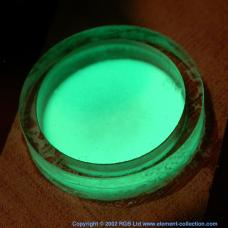Promethium facts for kids
Promethium is a special chemical element with the symbol Pm on the periodic table. It has the atomic number 61, which means each atom of Promethium has 61 protons. It belongs to a group of elements called Lanthanides.
What makes Promethium unique is that all of its different forms, called isotopes, are radioactive. This means they naturally give off energy and tiny particles. Promethium and Technetium are the only two radioactive elements found before lead on the periodic table. Most Promethium we see is made by people, not found naturally. The longest-lasting type of Promethium is called 145Pm, and it has a half-life of 17.7 years. This means it takes 17.7 years for half of a sample of 145Pm to change into another element.
Contents
What is Promethium?
Promethium is a very rare element. It's so rare that it was predicted to exist long before scientists actually found it. It's part of the lanthanide series, which are a group of elements often called "rare earth metals." These elements have similar chemical properties.
Because Promethium is radioactive, it's not stable. Its atoms slowly break down over time, releasing energy. This radioactivity is what makes it useful for some special jobs.
How Was Promethium Discovered?
Scientists first found Promethium in 1945. It was discovered by three American scientists: Jacob A. Marinsky, Lawrence E. Glendenin, and Charles D. Coryell. They found it at Oak Ridge National Laboratory in the United States.
They didn't find it in nature directly. Instead, they found it among the leftover materials from a nuclear reactor that was splitting uranium atoms. This process is called nuclear fission. They were able to separate and identify this new element, which they named after Prometheus, a character from Greek mythology who brought fire to humans.
Where is Promethium Found?
Promethium is extremely rare in nature. It's mostly found in tiny amounts within uranium ores, like uraninite, where it's created as a product of uranium's natural radioactive decay. However, the amounts are so small that it's very hard to extract.
Because it's so rare in nature, almost all the Promethium used today is made artificially in laboratories. Scientists create it by splitting uranium atoms in nuclear reactors.
How is Promethium Used?
Even though Promethium is radioactive and rare, it has some interesting uses:
- Illuminated Dials: One of its main uses is in the illuminated numbers on some clocks or other devices. The radioactivity makes the numbers glow in the dark without needing electricity.
- Thickness Measurement: The beta radiation that Promethium gives off can be used to measure the thickness of materials. As the radiation passes through a material, some of it is absorbed. By measuring how much radiation gets through, scientists can figure out how thick the material is.
- Atomic Batteries: Promethium can also be used in very small, long-lasting batteries called "atomic batteries" or "radioisotope thermoelectric generators." These batteries convert the heat from radioactive decay into electricity, which can power things for a very long time, like spacecraft.
Related pages
| Periodic table | |||||||||||||||||||||||||||||||||||||||||
|---|---|---|---|---|---|---|---|---|---|---|---|---|---|---|---|---|---|---|---|---|---|---|---|---|---|---|---|---|---|---|---|---|---|---|---|---|---|---|---|---|---|
| H | He | ||||||||||||||||||||||||||||||||||||||||
| Li | Be | B | C | N | O | F | Ne | ||||||||||||||||||||||||||||||||||
| Na | Mg | Al | Si | P | S | Cl | Ar | ||||||||||||||||||||||||||||||||||
| K | Ca | Sc | Ti | V | Cr | Mn | Fe | Co | Ni | Cu | Zn | Ga | Ge | As | Se | Br | Kr | ||||||||||||||||||||||||
| Rb | Sr | Y | Zr | Nb | Mo | Tc | Ru | Rh | Pd | Ag | Cd | In | Sn | Sb | Te | I | Xe | ||||||||||||||||||||||||
| Cs | Ba | La | Ce | Pr | Nd | Pm | Sm | Eu | Gd | Tb | Dy | Ho | Er | Tm | Yb | Lu | Hf | Ta | W | Re | Os | Ir | Pt | Au | Hg | Tl | Pb | Bi | Po | At | Rn | ||||||||||
| Fr | Ra | Ac | Th | Pa | U | Np | Pu | Am | Cm | Bk | Cf | Es | Fm | Md | No | Lr | Rf | Db | Sg | Bh | Hs | Mt | Ds | Rg | Cn | Uut | Fl | Uup | Lv | Uus | Uuo | ||||||||||
|
|||||||||||||||||||||||||||||||||||||||||
Images for kids
-
Uraninite, a uranium ore and the host for most of Earth's promethium
See also
 In Spanish: Prometio para niños
In Spanish: Prometio para niños






